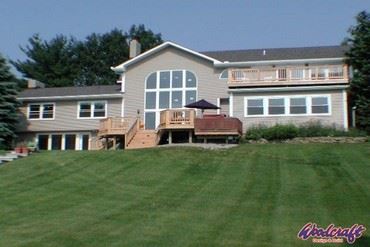Trex Decking: 7 Reasons to Choose Composite

The reasons to add a deck to any property are clear. From the additional space to host guests and the increase in home value to the aesthetic appeal and relatively low-cost, homeowners who choose to add a deck when faced with the decision about how to spend funds they have allocated toward home improvement projects are making a rewarding decision. From there, the choice becomes less clear for some, especially first time home owners whose experiences with decks may be limited to the wood structures they recall from childhood homes. When adding a deck for the first time, however, choosing composite Trex Decking is often the best way to go. Below are 7 reasons to trust a new deck to Trex.
1. Trex is long-lasting. When compared to decks built from wood, composite decks have a considerably long life. Unlike decks constructed only out of wood, composite decks, which contain a vinyl and other recycled materials in addition to wood last stand up better to the elements. Rain, wind and the sun’s rays all take a higher toll on wood than they do on composite.
2. Trex requires less maintenance. Composite decking was specifically designed as an answer to the complaints about traditional wooden decks. One frequently shared complaint is over the amount of maintenance a wood deck requires over time in order to maintain an attractive appearance. This includes attention to cracks, mold, splintering and rotting. Composite decking, on the other hand, requires relatively little maintenance. Splintering, rotting, mold and annual staining or sealing are not serious concerns for homeowners who choose Trex decking. While minimal surface mold and stains can occur with composite decks, both issues are quickly and easily addressed by cleaning the deck with simple household cleaning solutions and a gentle brush. When compared to the hours and even days of work it can take to stain, sand and power-wash a deck made of wood, the choice is a no-brainer. When it comes to splintering composite decks do not present any problem at all, making them an excellent choice for homes where the bare feet of children are likely to be paying a visit. An added bonus for families who like to kick off shoes when lounging outdoors? Trex decks do not overheat like their wooden counterparts.
3. Trex decks retain a uniform color. Color uniformity is one of the most popular reasons that homeowners choose Trex. Since the composite material is a uniformly mixed batch, every single board looks he dame as the one next to it. This is an enormous advantage over wooden decks, which, if not sealed and stained regularly, are susceptible to fading into a dusty silver-grey color.
4. Trex is naturally resistant to pests and rot. Wood decking has to be treated to be made resistant to pests. This is typically done by infusing it with heavy metals, such as arsenic, and pesticides, during a pressure treating process. As the wood deteriorates over time, these treatments can become dangerous for children and animals as well as adults. Going without these treatments leaves wood vulnerable to pest invasions. Composite decking, such as Trex, on the other hand, is naturally resistant to pests as well as to fungi and decay as a result of both the materials used to construct it and the process used to manufacture it.
5. Trex decking is always being improved. Unlike wood, which is a natural substance that remains unchanged and unchangeable over time, composite decking can constantly be improved over time. Research and development teams are continually working to solve problems and to improve the product. This has resulted in advances in how the product looks, making composite more wood-like in appearance since it was first introduced, as well as helping to keep colors brighter and more even. This means that when homeowners choose Trex they can rest assured that they are getting the best possible product that is the result of the most up-to-date research, manufacturing techniques and materials.
6. Trex is environmentally friendly. Building a traditional deck requires the use of many trees, the number depending upon the size of the deck. In addition to the reducing the shade and shelter that some other plants and animals depend upon for survival, every tree cut down decreases the amount of oxygen that is released in to the environment. Trex, on the other hand, as the first and largest composite decking manufacturer, recycles approximately 6 million pounds of plastic each and every year. This is because composites are usually made out of waste, including saw dust, old plastic milk jugs, shopping bags and other items typically thought of as garbage. In fact, unlike traditional wooden decks, which can impact the environment negatively by encouraging the chopping down of trees, every 20 feet of Trex decking actually saves 30 pounds of material from its fate in a landfill.
7. Trex decks come in at a similar cost to wooden decks over the lifetime of a deck. The initial investment in a wooden deck can fool some homeowners into thinking that the cost of a Trex deck is more than the cost of a wooden deck. The fact is, however, that after factoring in the cost of yearly maintenance for a wooden deck over a decade, the total cost of the inital purchase plus maintenance are nearly identical. Further, if a homeowner intends to do any of the maintenance for a wooden deck himself or herself the cost of his or her time should also be factored in to the total cost of owning the deck. When the difference in overall price is negligible, making the choice to have Trex decking is a no-brainer.
To talk more about how Trex decking can improve the look and function of any property, please contact us. Thank you.




